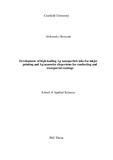JavaScript is disabled for your browser. Some features of this site may not work without it.
| dc.contributor.advisor | Zhang, Qi | |
| dc.contributor.advisor | Kirby, Paul B. | |
| dc.contributor.author | Kosmala, A. | |
| dc.date.accessioned | 2013-01-21T15:43:38Z | |
| dc.date.available | 2013-01-21T15:43:38Z | |
| dc.date.issued | 2012-03 | |
| dc.identifier.uri | http://dspace.lib.cranfield.ac.uk/handle/1826/7754 | |
| dc.description.abstract | The work presented in this thesis focuses on the synthesis of nanomaterials, formulation and printing of Ag nanoparticle and nanowire inks for two distinct applications: a) inkjet printing of Ag nanoparticle films on ceramic substrates with the aim of providing a smaller size of printed feature at lower cost than that can be obtained with the conventionally used screen printing, and b) Ag nanowires films prompted by the wide quest of electronics industry for materials with increased flexibility, lower cost and higher transmittance to replace indium tin oxide. Ag nanoparticles with a size of 50 nm were successfully synthesized and dispersed in aqueous medium. Two preparation routes were compared in order to distinguish the effects of solvents treatment of particles and their influence on the suspension characteristics including Ag loading, rheology, surface tension and later the electrical film properties. The co-polymer Pluronic F127 was found to be an effective as a stabiliser leading to the formulation of high silver loading in inks. The processing and characterization of silver films was performed. The aim was to reduce the number of layers in the silver nanoparticles film by increasing the thickness of a single layer with the goal of obtaining a dense and conductive film. An increase in the Ag loading, from 5 wt % to 45 wt % favoured the achievement of denser and thicker film with one layer printing. Addition of SiO2 to the ink formula resulted in denser structure and better adhesion of the printed track then the one without SiO2. A new method for improving the morphology of inkjet printed tracks has been proposed by printing the ink into the structured channels with predefined topography. Silver nanowires were synthesised and dispersed in methanol with help of copolymer F127. They were subsequently deposited on plastic and glass substrates forming conductive and transparent films. | en_UK |
| dc.language.iso | en | en_UK |
| dc.publisher | Cranfield University | en_UK |
| dc.rights | © Cranfield University, 2012. All rights reserved. No part of this publication may be reproduced without the written permission of the copyright holder. This thesis is submitted in partial fulfilment of the requirements for the Degree of PhD | en_UK |
| dc.title | Development of high loading Ag nanoparticle inks for inkjet printing and Ag nanowire dispersions for conducting and transparent coatings | en_UK |
| dc.type | Thesis or dissertation | en_UK |
| dc.type.qualificationlevel | Doctoral | en_UK |
| dc.type.qualificationname | PhD | en_UK |
